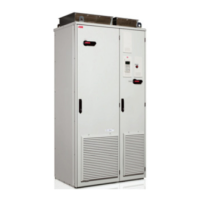Operation principle and hardware description 41
Electrical power network supervision functions
The inverter control program includes electrical power network supervision functions. The
inverter monitors, for example, overvoltage, undervoltage, overfrequency, underfrequency
and frequency change rate in the electrical power system. The functions are used for
disconnecting the inverter from the power system in power system fault situations. The
disconnecting times and frequency limits depend on the owner of the power system and
local legislation.
The inverter also provides the electrical power network supervision functions with certified
monitoring relays (options +Q969, +Q974, +Q975 and +Q980).
K20 Grounding contactor
(with options +F282
and +F283)
The inverter software controls the disconnection of the positive/
negative pole grounding. See section Positive or negative pole
grounding (options +F282 and +F283) on page 42.
Q1 AC main switch Hand-operated switch which connects the inverter to the electrical
power system.
The AC main switch can be operated at all times. If it is operated
during operation, the inverter will trip as the grid disappears.
Q2 DC main switch Hand-operated switch which connects the inverter to the solar
generator.
Q10 Auxiliary control
voltage switch
Hand-operated switch which connects the auxiliary control voltage to
the inverter.
T10 Auxiliary voltage
transformer (with
options +G396,
+G397, +G398 and
+G415)
Provides auxiliary voltage for the inverter circuit boards, cooling fans
and contactor control circuits.
U1
U3
U5
Inverter module Converts the DC voltage to AC voltage. The operation is controlled
by switching the IGBTs
U2
U4
U6
LCL filter Smooths the current and voltage waveform.
Z1.1-3
Z2.1-3
Z3.1-3
Common mode filter The filter reduces common mode voltages and currents in the solar
generator and inverter main circuit and AC output.
Z10 EMC filter
(option +E216)
EMC filter for low-voltage distribution networks.
Symbol Terminal/Component Description/Operation

